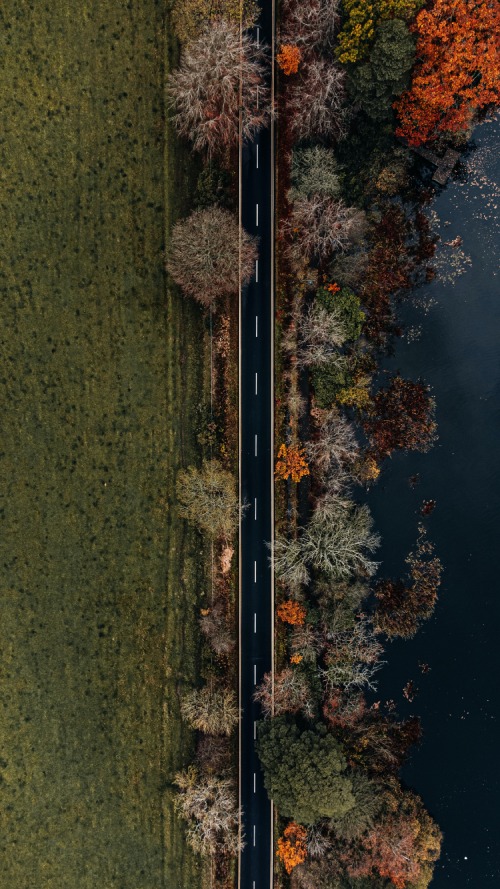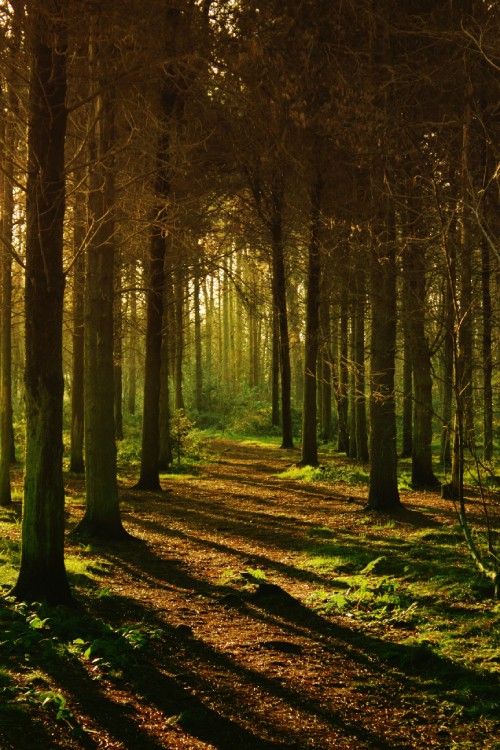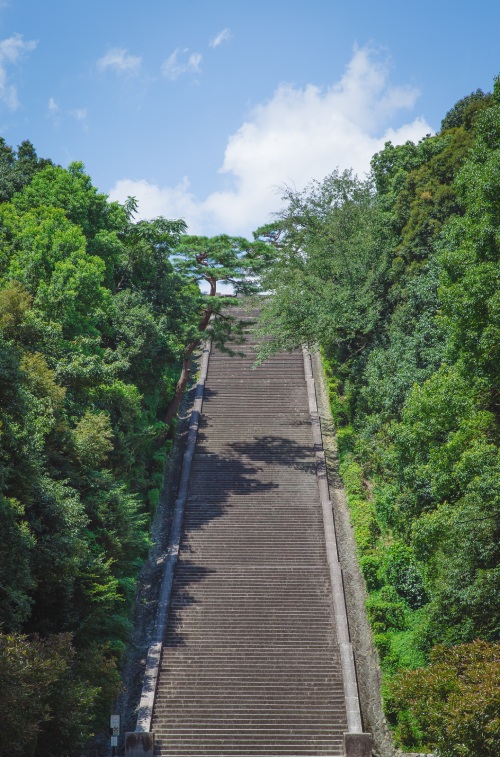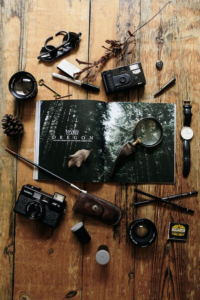Photography is not just about clicking and capturing. It is an art you can hone if you are well-versed in the craft of photography. A critical aspect of photography is framing. Photographers often use leading lines to frame their photos in the best manner possible.

What are Leading Lines?
Leading lines are lines in a photograph that have been framed and positioned by the photographer to direct the viewer’s attention to a particular point of focus. These lines frequently guide the viewer’s attention in a specific direction or to a specific area of the shot.

Importance of Leading Lines in Photography
The viewer is guided through a composition by leading lines. As a result, by properly putting leading lines in the frame, you can bring attention to important parts of a photograph, such as a gorgeous mountain or an ocean sunset. In other words, you may use leading lines to direct the viewer’s attention to the parts you want them to see – and to steer them away from the sections you don’t want them to see.
Leading lines can also be used to generate flow, often known as dynamism, throughout a composition. The viewer is automatically taken on a journey around the photo by the leading lines, which keeps them engaged. In addition, leading lines are an excellent method to make a picture appear three-dimensional. You may create a 3D appearance in breathtaking landscape photography by highlighting the start of a line before letting it fade away into the background.

Some Examples of Leading Lines
Find Leading Lines
Leading lines may be seen anywhere, no matter where you reside or where you like to snap images. It may not appear so, yet it is true. Start with a path; paths are inherently leading since they lead somewhere, and the path borders frequently produce a vanishing point on the horizon. Paths can also be found almost anywhere – in forests, parks, the city, and even the countryside. There are, however, a plethora of other prominent lines to choose from. Photographers employ a variety of objects in their compositions, including sand patterns, fallen logs, bouquets of flowers, fascinating rocks, bridges, fences, and more. Here’s a comprehensive list of things to think about:

Man-Made Leading Lines
- Roads
- Fences
- Boardwalks
- Bridges
- Bricks
- Anything in a row, such as lamp posts
- Buildings
- Doorways
- Window Panes

Nature-Made Leading Lines
- Rivers
- Shorelines
- Waves
- Sand Dunes
- Trees
- Tall Grass
- Cliffs
- Rocks
- Sunrays

Types of Leading Lines Photography
To utilize leading lines effectively, you must first grasp the various sorts of leading lines and how they should be used. The following are some examples of leading lines:
Horizontal Lines
In nature and landscape photography, horizontal leading lines are common. Horizontal leading lines are commonly utilized when shooting with a wide-angle lens since they span over the entire breadth of the image.

Vertical Lines
Vertical lines have a tendency to convey power and hierarchy. They can be used to communicate status in your photograph by drawing the eye up or down within the frame. In fashion and street photography, vertical leading lines are frequently used.

Curved Lines
Curved lines, on the whole, appear more natural than straight lines. Leading lines are most commonly employed in nature photography to highlight distinct landmarks.

Diagonal Lines
To generate a sensation of movement and change, diagonal lines are used. Diagonal lines commonly trace from foreground to background to convey a sense of distance. Try experimenting with diagonal lines to increase the sense of depth in your image if you are dealing with a large depth of field.

Converging Lines
If your frame has converging lines, it’s ideal to place the image’s subject at the intersection of these leading lines. Converging lines can be a strong compositional feature to include in your images since they are quite good at attracting attention to the point of convergence.

Implied Lines
These are lines that are not physically there in the image but can be imagined. A human gaze is the best example of this. We automatically follow someone’s line of sight in order to see what they are looking at, and this can be a highly effective leading line in a composition.

Intersecting Lines
Lines that cross over one another should be avoided since they can disrupt the flow of a photograph and lead the viewer to lose interest in the line. You can, however, take advantage of this by using intersecting lines to intentionally create a sense of tension and confusion in your photo.

Leading Lines vs Paths
The distinction between a leading line and a path is straightforward. Lines are used in both strategies to guide your attention, but they serve different purposes. A leading line leads you to the focal center of the image. A path has a tendency to lead to a dead end.
This image, for example, uses a leading line to direct your attention to the snowy mountains.

Difference Between Leading Lines and Paths
It’s crucial to understand the difference between leading lines and paths as you improve your photographic skills. Leading lines and paths are both compositional methods that use lines to bring the viewer’s eye to something and create a feeling of perspective in a picture. Paths, unlike leading lines, serve as a compositional tool that always pulls the viewer’s attention to the horizon line. Leading lines are more versatile since they can be utilized to attract the viewer’s attention to a main focal point or point of interest that varies based on the photographer’s main subject.
Tips for Using Leading Lines in Your Photography
Evaluate Time and Location
Are you in a natural setting or in a city surrounded by skyscrapers? Is it past your bedtime? If this is the case, the sun’s rays may create long shadows that can be employed as leading lines. All of these inquiries can help you figure out how leading lines can benefit your photos.
Look for Natural Lines
Scan the region where you will be shooting for natural and manufactured structures that could be used to generate strong leading lines in the frame.
Decide your Focal Point
Your location may be brimming with excellent leading lines, but it’s up to you to figure out which ones are appropriate for your topic. You could be shooting beside train tracks or among lampposts, but unless you can align these lines with your image’s focal point, they will simply serve to confuse the spectator.
Positioning
Once you have decided which leading lines to use, position your camera so that the lines bring your attention to the image’s main point. Take your time, but keep in mind that if you are utilizing shadows as leading lines, you will need to account for how they shift over time.
Lighting Conditions
After you have framed your shot, assess the lighting conditions and change your shutter speed and aperture accordingly. Strong leading lines cannot make up for an under or overexposed photo, so make sure your camera is set to the right exposure.
Click Multiple Shots
When it comes to editing your photos and selecting your favorites, it is always a good idea to give yourself options. To make sure you have covered all of your bases, change up your viewpoints and camera settings.
Use the Widest Lens You Have
To make great leading line compositions, you don’t need a wide-angle lens. However, it is quite beneficial. Why? A wide-angle lens, on the other hand, allows you to capture a large picture – allowing you to place leading lines near the bottom of the frame, then let them flow into the shot, gradually drifting farther and farther away until they vanish. In contrast, in a telephoto composition, the leading lines usually begin near the subject and end abruptly. Less intriguing, less dynamic, and less three-dimensional. For this reason, many landscape photographers use ultra-wide focus lengths.
Do not be Scared to Use More than One Leading Line in a Single Composition
A single leading line is good, but if you can locate several leading lines that all drive the spectator to your main topic, your composition will be unbelievably powerful. For example, you could gesture to a distant peak by using both edges of a road. You might also point to a blue ocean by drawing two lines in the sand, one starting in the bottom right and the other in the bottom left.

Keep in mind that as much as feasible, all of your leading lines should direct toward the subject. If the lines stray from your topic, the viewer will be led in the wrong way, preventing them from properly appreciating the image. It may take some ingenuity to get two or more lines to converge toward your subject, but the end result will be well worth it.
Make Use of Near-Far Technique to Create Depth
In landscape photography, the near-far method is very popular. It is a quick and easy technique to add gobs of depth to your images, and it is how you can get shots like this:

First and foremost, make sure your leading line is eye-catching. It should act as a stand-alone subject, similar to a fascinating rock or a patch of vibrant flowers.
Second, make sure you’re shooting with a long focal length. Working with a focal length of at least 35mm (on a full-frame camera) is ideal, but 24mm, 18mm, or even 14mm is even better.
Third, set up your camera on a tripod and get low to the ground to photograph your subject. Even if it takes getting a few inches away from your subject, you want to make the leading line prominent in the frame. In order to maintain both the foreground and the background sharp, choose a narrow aperture, such as f/8, f/11, or even f/16.
How and Where to Search for Leading Lines?
Search for Leading Lines in Trees
Look for strong converging lines and points on streets, alleyways, or trees. To get the subject’s head straight at the right converging point of the leading lines, you will have to either tippy-toe or crouch down and work the scene.

Search for Leading Lines in Walking Paths
On concrete or dirt roads, look for leading lines. Vertically frame your photos to accentuate the leading line. Also, try to make it lead to a fascinating topic.

Search for Leading Lines in Arrows
Look for leading lines in the form of arrows when you are out shooting. Then wait patiently for your subject to enter the picture at the appropriate time. Make sure to click and time the photo such that the leading line points directly at the subject.

Search for Leading Lines by Crouching Down Low
When you crouch down and shoot, diagonals and leading lines are highlighted. With wide-angle lenses, you’ll also notice that leading lines and diagonals are more vibrant (35mm, 28mm, or wider). So, when firing leading lines, stoop more, especially if the lines are above you.

Search for Leading Lines by Making Subject Stand at the Right Spot
With your friends, family, or loved ones, practice leading lines. They are the ones who have the most patience. You can also get a good photograph out of it.

Conclusion
Leading lines are the fundamental compositional components in a photograph that guide our gaze through the image. They can be used to tell a tale, emphasize a point, or establish a link between two objects.
So, wherever you go, start thinking about leading lines. In the midst of ordinary chaos, practice finding leading lines. Your compositions will improve dramatically in a short period of time.














